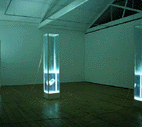| The Warm War Christopher Bell Stripp Gallery 7 May - 24 May, 1997 Melbourne |
||
 Christopher Bell, The
Warm War, |
Duchamp once remarked that
"a painting which doesn't shock isn't worth
painting". Duchamp, famously of course, gave up on
painting (just as he did the readymades) once they lost
their ability to surprise the viewer. Christopher Bell's
submerged electrical appliances are plugged into this
same problem: How can an art work startle its audience?
How can an audience who has "seen" everything,
"feel" shocked by an art object? Bell's recent exhibition consists of a series of domestic clothes irons dangling precariously by their cords into the brightly lit water of three large aquarium-like tanks. Like the luminescent wares of department store display counters, their utility as clothes irons is outstripped; not only by the aura of their aesthetic appeal, but by the hopes and fears, goals and achievements which are miraculously invested in commodities. However, as all window shoppers know, the kind of pleasure to be had from wandering around a department store (or gallery for that matter) isn't necessarily contingent upon one's ability to purchase the product in mind. Rather, the charge that one feels is more often the result of one's experience of, or engagement with, the encounter. It is with this basic idea in mind - of the attraction and fascination of an encounter - that you can address the kind of spectatorial pleasure of Bell's tanked irons. It is also from this point of view that his work is most startling. His appropriation and recontextualisation of household appliances within the space of the gallery - an encounter which, after Duchamp, has become increasingly banal - does pose a number of now familiar questions concerning the gallery's consecration of everyday objects as "art". But the shock or, perhaps more appropriately, the charge of Bell's work comes from another, rather more dynamic encounter. The force of this encounter has its roots in Bell's predilection for submerging electrical appliances in water. He has engaged in this practice for a couple of years now, using televisions, toasters, lamps and now irons. The phosphorescence of the tanked televisions and lamps made the danger quite salient because the appliances illuminated the water to emphasise that everything was electrically "live". His irons, however, attested to this more subtly with the warmth of the tanks, and the silent, sinister, bubbling of the irons. Needless to say, the viewer's too-close encounter with these reservoirs of electricity leaves much to the imagination; most of which is pretty frightening. Like a visit to Marineland, Bell's electrified tanks prompt us to question the faith we invest in the capacity of glass to protect us from what it encases; be it the electric eels at the aquarium, or Bell's not aesthetically dissimilar household irons. But just as the open jaws of the twelve foot sharks at Marineland keep us coming back for more, it is the almost palpable danger bottled in Bell's tanks which constitutes their imminently fatal attraction; no less for the viewer than for the artist himself, who despite (or because of) the danger, continues to submerge his appliances. We all know that electricity is potentially very dangerous; which is why we only allow it to infiltrate our homes, caged and concealed in smooth, congenially polished casings. We also know that imperceptibility doesn't equal innocuousness; which is why our parents brought us up on tragic tales of careless kids who were electrocuted by sticking a knife into a toaster, or dropping a hair dryer into a bath. It is this economy of fear (fostered by the literal and potentially pernicious status of Bell's work as "shocking") which enables his exhibition to corporeally move the viewer beyond both the not so shocking "shock" elicited by his recontextualisation of the everyday in the space of the gallery, and the peculiarly intense desire we may feel for a commodity such as an iron. Bell is like that mythical kid your parents always warned you about. The difference is that Bell has survived to tell the tale, and to demonstrate that the result of a fascination with something as forbidden, powerful and dynamic as electricity, doesn't have to be as ugly as they made out. As his tanked irons attest, the result can be sublime. Tara Forrest |
|
 Christopher Bell, The Warm War, |
||
 Christopher Bell, The Warm War,
|
||
|
||